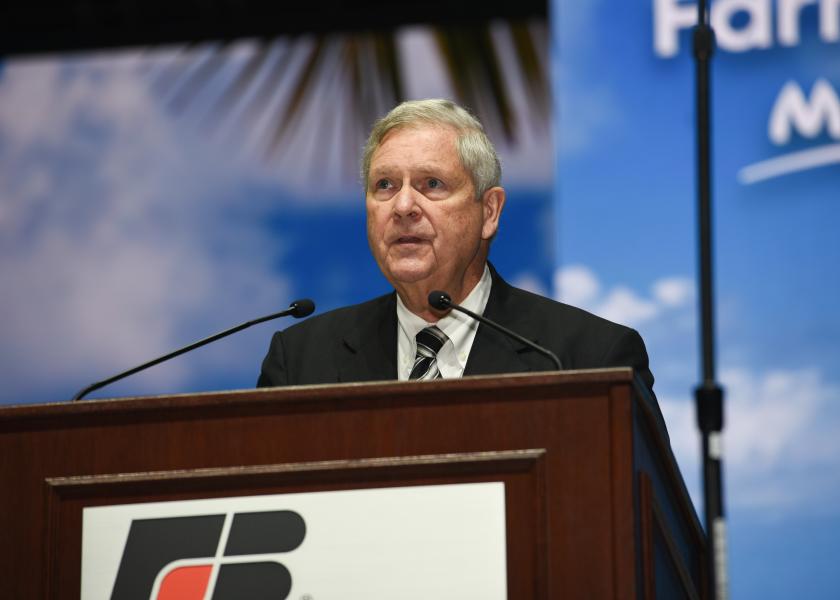Vilsack Lists USDA's 4 Policy Objectives for 2023

USDA Secretary Tom Vilsack has a history of making key announcements during visits, and that was the case during his appearance at the American Farm Bureau Federation’s annual meeting in Puerto Rico.
Some of them include:
1. ERP Phase 2
Vilsack announced Phase 2 of the ERP, which will provide help to producers for production and quality losses of eligible crops, utilizing calculations of a producer’s decrease in gross revenue.
Those were about to be released months ago but were pulled back at the last minute due to lawmaker and farmer complaints. USDA eventually announced anyway.
USDA said in documentation on file at the Federal Register that using that approach will reflect the losses “without requiring the more extensive calculations and documentation required under previous programs” for disaster-related crop losses. USDA said this streamlines the aid to minimize the burden on producers and processing of applications by county FSA offices. Using that process also means it will address losses for a qualifying disaster event whether it happened before or after harvest.
ERP Phase 2 will be available for a decrease in gross revenue in 2020 or 2021, primarily to those with losses not covered by Federal Crop Insurance or the Noninsured Assistance Program (NAP).
The application period is Jan. 23-June 2. USDA has already paid out $7.31 billion under ERP Phase 1 as of Jan. 8, up from $7.28 billion the prior week, including $6.23 billion for non-specialty crops ($6.21 billion prior) and $1.09 billion for specialty crops ($1.08 billion prior). A total of $10 billion was earmarked for ERP.
USDA projects outlays for ERP Phase 2 payments will be $1.2 billion and will likely be pro-rated as USDA projects total gross outlays at $1.5 billion.
Phase 2 Reflection
Phase I was highly successful and it worked well. Phase 2 has tons of problems. Comparing schedule F in relevant years to past years doesn’t reflect losses. A farmer may have had to sell land or livestock when they didn’t want to. They may have sold a previous year’s crop in the year in question. These and other things skew the schedule F. There is also the issue of forcing farmers to share schedule F info with local FSA offices.
2. Pandemic Assistance Revenue Program (PARP)
Vilsack announced PARP payments for producers that suffered a 15% or greater decrease in allowable gross revenue for the 2020 calendar year compared with either 2018 or 2019. This effort, Vilsack said, aims to “fill in gaps” for losses covered by either Phase 1 or Phase 2 of ERP.
The payments will have a factor of 80% (90% for underserved farmers and ranchers) and will be reduced by 2020 ERP payments, and pandemic assistance under either the Coronavirus Food Assistance Program (CFAP) 1 or 2 and other pandemic aid.
Payments will be limited to $125,000 per person or entity and USDA may set a lower maximum payment amount per person if total payments exceed available funding and USDA expects that to be the case — PARP outlays are projected at $250 million with gross outlays pegged at $2.66 billion.
USDA also will expand payments under prior efforts such as CFAP 2 and others. The total payments USDA projects under the ERP Phase 2, PARP and expanded other programs is $1.82 billion with gross amounts at $4.54 billion.
3. U.S.-Made Fertilizer
USDA will seek public comment on 21 potentially viable projects totaling up to $88 million to boost U.S. fertilizer production via the first round of USDA’s Federal Production Expansion Program, a $500 million effort announced earlier this year.
The projects are in Alabama, Arizona, Colorado, Florida, Iowa, Louisiana, Massachusetts, Minnesota, Missouri, Montana, Ohio, Oregon, Texas, Washington, and Wisconsin. USDA is seeking comments through Feb. 8 on the environmental impacts of the projects.
4. Meat and Poultry Processing
Vilsack announced three projects in Ohio, Michigan and Minnesota which will expand independent meat and poultry processing capacity via the Meat and Poultry Processing Expansion Program.
The projects total $12 million and are in addition to other recently announced efforts in the sector.
More on policy:
We Have ERP Phase II
Policy and Payments: What Producers Can Expect in 2023







